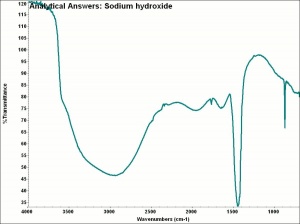Difference between revisions of "Sodium hydroxide"
m (Text replace - "== Authority ==" to "== Sources Checked for Data in Record ==") |
m (Text replace - "\[http:\/\/cameo\.mfa\.org\/materials\/fullrecord\.asp\?name=([^\s]+)\s(.*)\]" to "$2") |
||
| Line 1: | Line 1: | ||
== Description == | == Description == | ||
| − | White, deliquescent solid. Sodium hydroxide was the 8th highest-volume chemical produced in the U.S. in 1991. It is primarily used in the manufacture of chemicals, paper, soaps ([ | + | White, deliquescent solid. Sodium hydroxide was the 8th highest-volume chemical produced in the U.S. in 1991. It is primarily used in the manufacture of chemicals, paper, soaps ([[castile%20soap|castile soap]]), cleaners (Drano) as well as for [[mercerized%20cotton|mercerizing cotton]], and neutralizing acids. It is also used to digest cellulose in making [[viscose%20rayon|viscose rayon]] and [[cellophane|cellophane]]. Historically, sodium hydroxide was obtained in an impure form from wood ashes and called soda lye. It was used to make a [[soap|soap]]. |
== Synonyms and Related Terms == | == Synonyms and Related Terms == | ||
Revision as of 12:18, 10 May 2016
Description
White, deliquescent solid. Sodium hydroxide was the 8th highest-volume chemical produced in the U.S. in 1991. It is primarily used in the manufacture of chemicals, paper, soaps (Castile soap), cleaners (Drano) as well as for mercerizing cotton, and neutralizing acids. It is also used to digest cellulose in making Viscose rayon and Cellophane. Historically, sodium hydroxide was obtained in an impure form from wood ashes and called soda lye. It was used to make a Soap.
Synonyms and Related Terms
caustic soda; sodium hydrate; lye; soda lye; white caustic
Other Properties
Soluble in water (pH is about 13 for a 0.5% solution). Soluble in glycerol, ethanol, methanol.
| Composition | NaOH |
|---|---|
| CAS | 1310-73-2 |
| Melting Point | 318 |
| Density | 2.13 |
| Molecular Weight | mol. wt. = 40.0 |
| Boiling Point | 1390 |
Hazards and Safety
Toxic by ingestion and inhalation. Highly corrosive to skin tissue.
LINK: International Chemical Safety Card
Sources Checked for Data in Record
- G.S.Brady, Materials Handbook, McGraw-Hill Book Co., New York, 1971 Comment: p. 737
- Richard S. Lewis, Hawley's Condensed Chemical Dictionary, Van Nostrand Reinhold, New York, 10th ed., 1993
- Susan E. Schur, Conservation Terminology: A review of Past & Current Nomenclature of Materials, Technology and Conservation, Spring (p.34-39); Summer (p.35-38); Fall (p.25-36), 1985
- Michael McCann, Artist Beware, Watson-Guptill Publications, New York City, 1979
- Matt Roberts, Don Etherington, Bookbinding and the Conservation of Books: a Dictionary of Descriptive Terminology, U.S. Government Printing Office, Washington DC, 1982
- Gordon Hanlon, contributed information, 1998
- The Dictionary of Paper, American Paper Institute, New York, Fourth Edition, 1980
- Van Nostrand's Scientific Encyclopedia, Douglas M. Considine (ed.), Van Nostrand Reinhold, New York, 1976
- The Merck Index, Martha Windholz (ed.), Merck Research Labs, Rahway NJ, 10th edition, 1983 Comment: entry 8772
- The American Heritage Dictionary or Encarta, via Microsoft Bookshelf 98, Microsoft Corp., 1998

